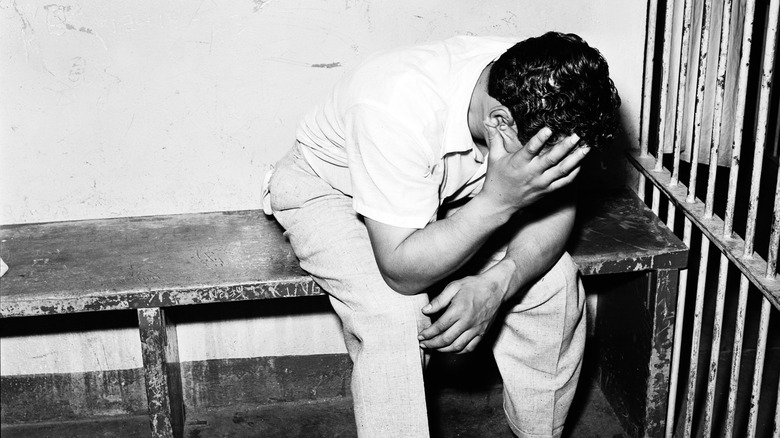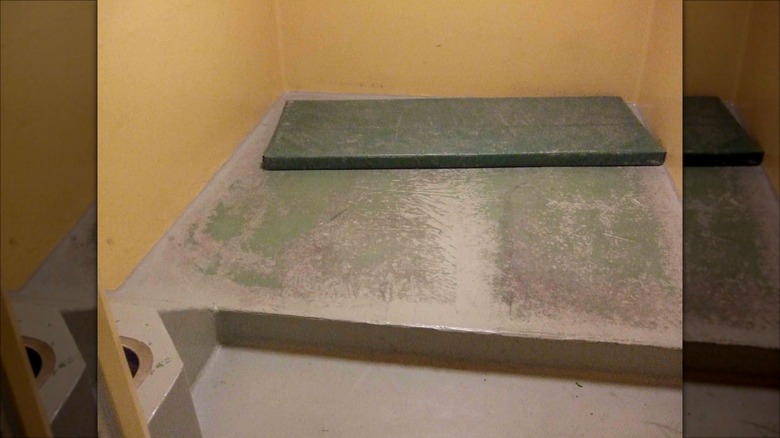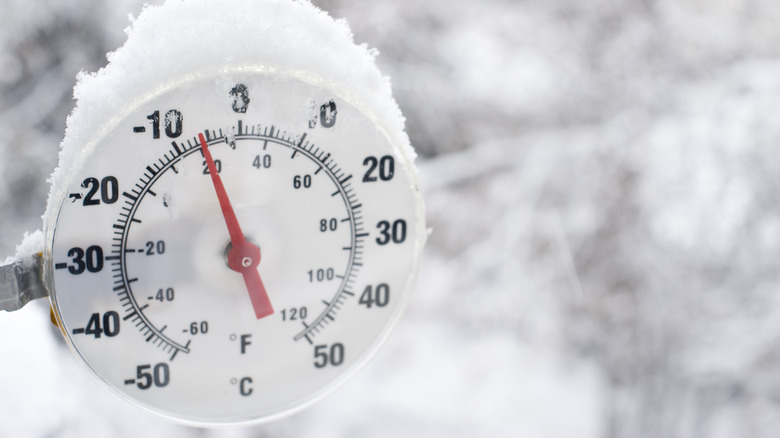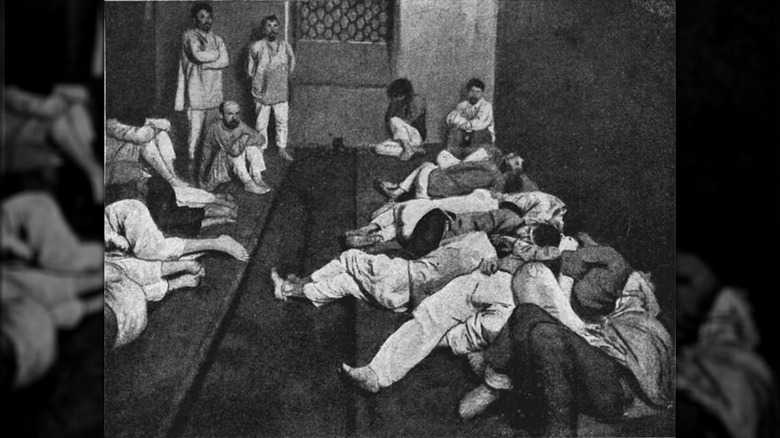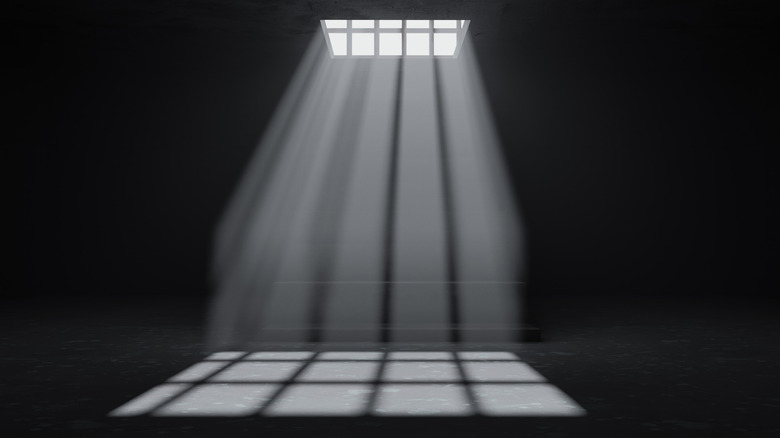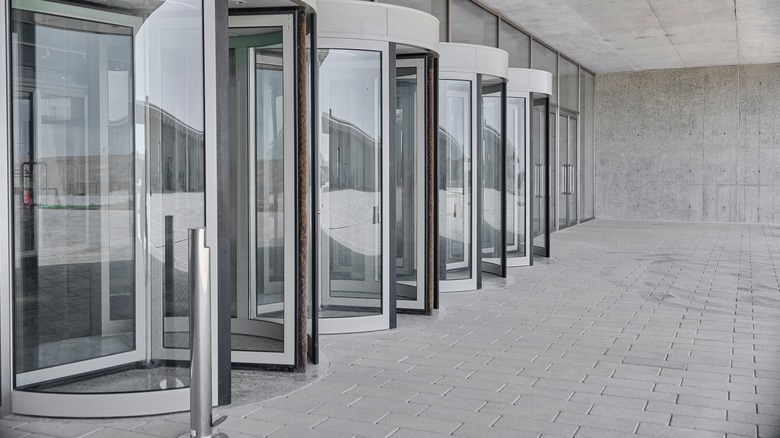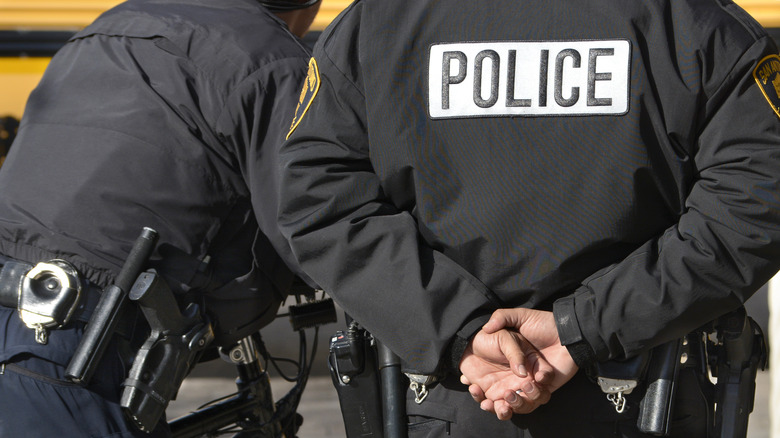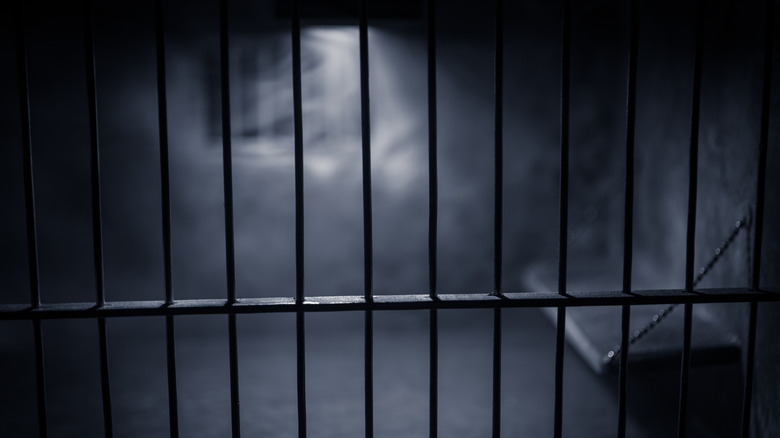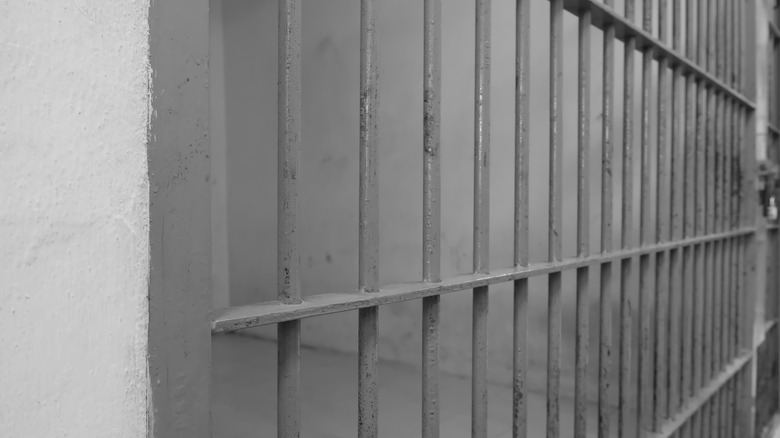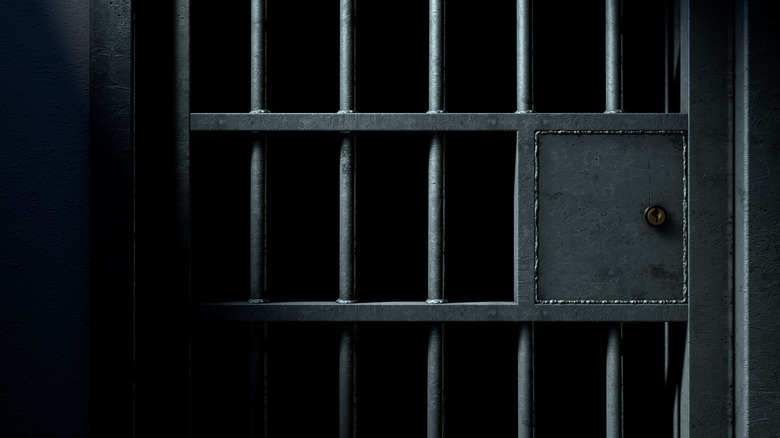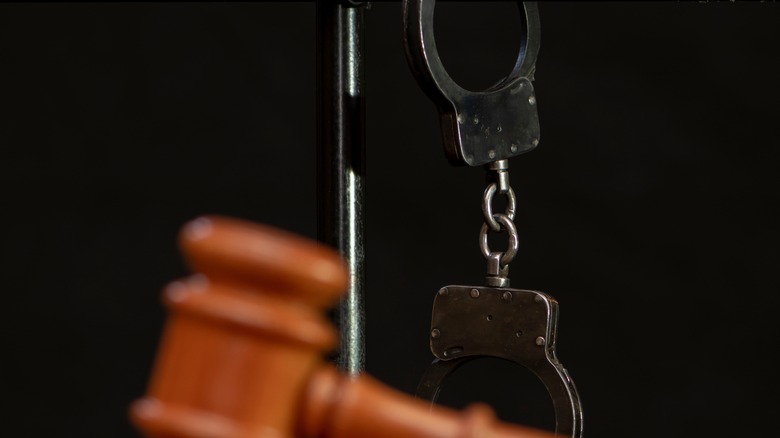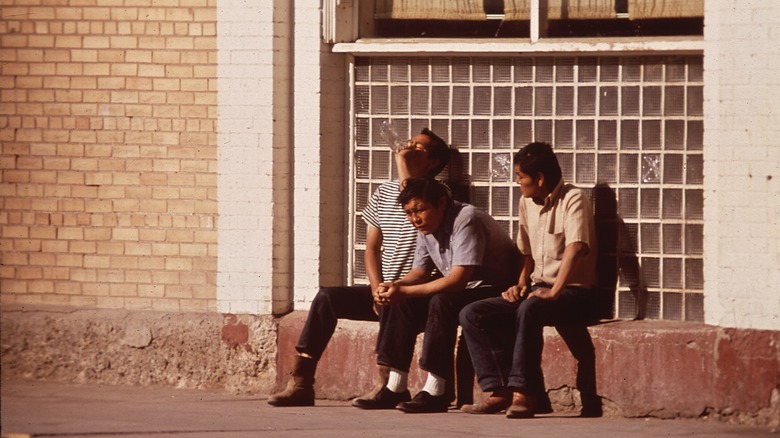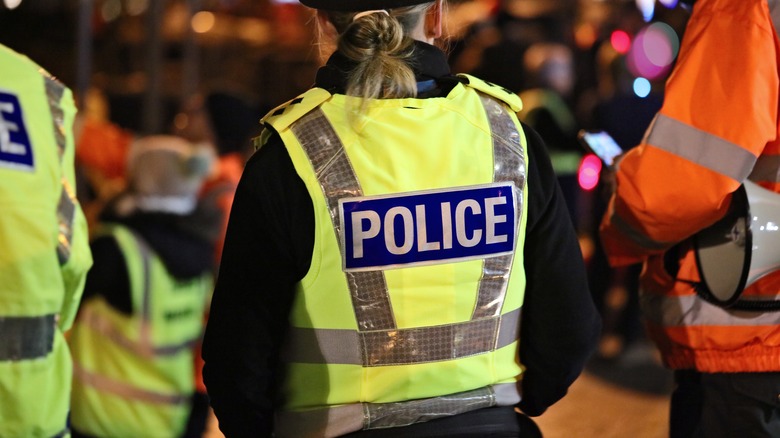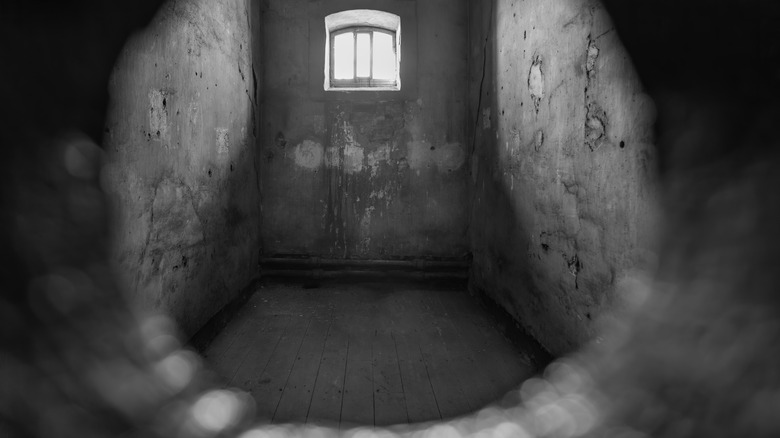The Dark And Grim History Of Drunk Tanks
Although not always called a drunk tank, the concept of imprisoning intoxicated people can be found all over the world. Also ubiquitous are its grim and dangerous conditions. Throughout history, drunk tanks have repeatedly been found to be inhospitable places that do little to aid intoxicated people in any way.
For most of the 20th century, drunk tanks received little oversight or attention and the idea that unhoused people would repeatedly spend nights in the drunk tank was so widespread that they were described as revolving doors. And despite their name, you don't necessarily have to be drunk to end up in a drunk tank. Police have been known to use drunk tanks to imprison children and activists, as well as using drunk tanks as a form of solitary confinement and psychological torture.
Although the use of drunk tanks has slightly decreased in recent years in favor of treatment centers, many places in the United States continue to practice imprisoning intoxicated people. Sometimes, people are held for days on end and tragically, some people don't make it out.
The following article includes descriptions of death, violence, and sexual assault.
What is a drunk tank?
In several countries around the world, including the United States, people who are publicly inebriated are typically arrested. But they aren't taken to a jail cell like the ones other imprisoned people are put into. Instead, they are put into what's known as a drunk tank, which is a smaller-sized cell within the jail that is usually used for holding intoxicated people, sometimes until their respective hearing in the morning. They vary in size and can hold up to two or 200 people.
By the first half of the 1970s, almost half of all United States jails had at least one drunk tank, according to "The Nation's Jail: A Report on the Census of Jails." Although some drunk tanks have lights, mattresses, and ventilation, this isn't a guarantee and some are nothing more than a small windowless cell with no toilet, no heating, and no bed. Often, there are also little-to-no medical services available to people.
Sociological Focus writes that public intoxication laws, which are the laws directly responsible for police arresting people and putting them into drunk tanks, are class-based laws and are selectively enforced. In the 1950s, unhoused people would repeatedly spend nights in the drunk tank, according to The Milbank Quarterly. And the 1970 study by Jacqueline P. Wisemen found that in places like Pacific City, Oregon, unhoused men made up almost half of all public intoxication arrests despite being only 3% of the city's population.
Left outside in extreme temperatures
In the late 1800s, some drunk tanks didn't even have the luxury of being part of the jailhouse building. Instead, they were isolated shacks that offered the sparsest protection from the elements. According to "The Bad Old Days of Colorado" by Randi Samuelson-Brown, in Colorado the drunk tanks, no bigger than a small closet and without ventilation, were found on city corners. This allowed police to readily confine an intoxicated person without having to go all the way to the jailhouse. And because the drunk tanks were little more than slabs of wood, the temperature inside fluctuated between extremes in the winter and the summer. Considering that deaths in drunk tanks continue to occur well into the 21st century, it's more than likely that there were unrecorded fatalities in these drunk tanks. But ultimately, it's unknown exactly how many people likely perished in these 19th-century drunk tanks.
Often, these drunk tanks were either made of wood or stone, which contributed to their extreme temperatures. And sometimes, they even ended up housing their own builders. Paul Kirkman writes in "Missouri Outlaws" that the builder of the stone drunk tank in Mokane, Missouri ended up being one of the first people to be held in it, an achievement that few other drunk tank builders can claim.
Akin to insane asylums
Drunk tanks of the 20th century be found in Russia during the Soviet Union (pictured) as well as in what was once the Kingdom of Norway. Introduced in 1904, holding facilities for drunk people became widely used during the Soviet Union and were known as vytrezvitel, which translated to literally mean "sobrieters."
According to "Alcohol, Psychiatry and Society," edited by Waltraud Ernst and Thomas Müller, the Soviet drunk tanks could hold up to 30 people at a time and charged people a fee to leave. If they were unable to pay, they were taken to a hospital for detox and treatment. Employers were also notified if one of their employees spent the night in a drunk tank. These Soviet drunk tanks saw a high number of fatalities that were caused by the lack of health and medical services within these facilities. The number of people who passed through the Soviet drunk tanks was staggeringly high, with up to 15% of the adult population spending at least one night in the drunk tank every year.
Over the border in the Kingdom of Norway, the situation wasn't much better when it came to the conditions in which people were held in the drunk tanks. Johan Scharffenberg, a Norwegian psychiatrist, wrote in the early 20th century that Norwegian drunk tanks were comparable to antiquated mental institutions, according to "A Stand Against Tyranny" by Maynard M. Cohen.
An unsanitary environment
Across the United States, drunk tanks are unsanitary and unsafe places. The small cells sometimes hold multiple people and offer no facilities like toilets or sinks. According to a reporter writing about drunk tanks in Washington, D.C., "the stench of cheap alcohol, dried blood, urine, and excrement covers the cell block," per "Jails, The Ultimate Ghetto" by Ronald L. Goldfarb. Due to the lack of access to basic sanitation facilities, the floor of drunk tanks is covered in a variety of fluids, and in places like California, wooden slats are used to keep people slightly above the layer of wet grime.
Although some drunk tanks have toilets, drinking fountains, and showers, these facilities aren't always available. In Philadelphia, the Pennsylvania Crime Commission found in their 1969 Task Force Report on Alcohol and the Criminal Justice System that "sanitation and ventilation are problems. Comfort and care are uncommon." Sometimes, people were kept in drunk tanks for months on end in crowded cells, with only one toilet and one washbowl for up to 200 people, according to the Citizens' Advisory Committee to the Attorney General of California on Crime Prevention
One of the times that the conditions of a drunk tank are taken into consideration is in regard to the sentencing decision. Goldfarb writes that in some counties, the public intoxication sentence may be suspended or dismissed provided that the arrested person cleans the drunk tank cell.
Revolving doors
In the 1950s, drunk tanks in the United States were criticized for how often unhoused people were taken into custody and held there, only to be released and returned again the following night. This situation was so pervasive that in 1958, drunk tanks were referred to as "revolving doors" and the metaphor has been used repeatedly since. In the 1970s, some people ended up in drunk tanks as often as five times a month, according to "Homelessness: A National Perspective", edited by Marjorie J. Robertson and Milton Greenblatt. In 1949, Liberty, per Silkworth, reported that intoxicated people who were brought into drunk tanks weren't fingerprinted, "so there is no way to keep track of how often they come back."
This practice of repeatedly jailing the same intoxicated people over and over again can be traced back as far as the 1830s. During a survey of local jails, poorhouses, and other public holding facilities in 1833-34 conducted by temperance pamphleteer Samuel Chipman found that "many of the intemperate have been committed repeatedly and always occasioned by arden spirit. In some instances, the intemperate spend more than half the time in prison solely on account of their intemperance."
The Florida Law Review notes that in 1965, one out of every three arrests in the United States was for public intoxication. And unhoused people have a much higher arrest rate, accounting for many of the revolving door arrests.
Police abuse in the drunk tank
Despite claiming that they are imprisoning intoxicated people for their own safety, police will often be the ones committing abuses against intoxicated people. This abuse can range from physical abuse and sexual abuse to psychological abuse. For example, the 1967 Crime Commission's Task Force on Drunkenness found that while being entered into the system, police officers would psychologically abuse intoxicated people and repeatedly insult them. There are also reports of physical assaults from police, as well as one accusation from the early 20th century that alleges the use of poison gas.
And while physical abuse isn't always caught on camera, ABC 13 reports that in August 2016, a security video was released from a drunk tank in Houston, Texas that showed a police officer slamming an intoxicated man's head against a jail door frame, leaving a trail of blood on the wall and floor as the man collapsed to the ground.
Human Rights Watch also found that police officers in Saskatchewan would repeatedly abuse indigenous women in drunk tanks. During one incident, police officers pepper sprayed an intoxicated woman after forcing her to strip and denied her water. There are also reports of women being sexually assaulted and sexually harassed by the Royal Canadian Mounted Police while being taken into custody into a drunk tank.
Withdrawing in the drunk tank
When intoxicated people are held in a drunk tank, often they withdraw from alcohol and drugs without any medical aid or treatment. Sometimes, police officers may even use the fact that people are withdrawing to draw information out of people. According to "The Addict and the Law" by A. Lindesmith, "the most effective punishment used to induce addicts to talk and to cooperate is, of course, the withdrawal distress," per "Jails: The Ultimate Ghetto" by Robert L. Goldfarb. And it's estimated that at least 50% of people end up cooperating due to police intimidation.
Police officers sometimes use withdrawal as an interrogation tactic, while other times they simply aren't informed and don't have the capacity to notice withdrawal symptoms. Sometimes, there will be numerous people detoxing and withdrawing from different drugs in the same room. Vice reports that after Beth Thompson was arrested by San Antonio Police in Texas, she was held in a space with 25 other people withdrawing from various drugs. According to Thompson, "You'll have someone throwing up next to someone who seems [to] be in schizophrenic psychosis."
Withdrawing isn't a quick or easy process and it becomes even more difficult when it occurs in a concrete room lacking any basic facilities. When Megan Dunn was forced to withdraw without medical care in the Walker County's jail in Jasper, Alabama, she was in so much pain that she "was literally praying to God to end me," according to CNN.
High risk of suicide
There is a notably high rate of suicide in drunk tanks, which is sometimes attributed to depression that occurs during alcohol withdrawal. Liberty reports that in July 1949, a woman in San Francisco, California died by suicide after being arrested and put in a drunk tank, per Silkworth. Her suicide note, which read "You don't know. I've gone through a thousand hells tonight," was scrawled on the on the wall in lipstick. And this was unfortunately one of many suicides that would occur in the drunk tank.
According to the 1980 report from the First National Conference on the Public Inebriate, intoxicated people who are put into drunk tanks have a high risk of suicide while imprisoned. In a study of North Carolina jails between 1972 and 1976, it was found that over 80% of people who died by suicide in jail were intoxicated.
Ultimately, the lack of oversight and medical aid at drunk tanks means that intoxication doesn't necessarily have to be a factor in the suicide. The Oklahoman reports that in April 1986, a 13-year-old boy died by suicide in a drunk tank, having been put there because state law requires that juveniles who are suspected of a crime be held separately from adults who are suspected of a crime.
If you or someone you know is struggling or in crisis, help is available. Call or text 988 or chat 988lifeline.org
Deaths in drunk tanks
Unfortunately, deaths while in police custody in drunk tanks are all too common and suicide isn't the only way that people lose their lives in drunk tanks. As recently as January 2023, CNN reported that 33-year-old Anthony Mitchell allegedly froze to death in a drunk tank in Alabama. Police officers had kept him in the freezing cold drunk tank for two weeks up until Mitchell's death.
In one year alone, 10 people died in a Philadelphia drunk tank in 1968, but it's unknown whether this number was high or low on average. Drug-related deaths are also common, due to the lack of police oversight and medical knowledge. Filter Magazine reports that after 29-year-old Alex Billmeyer was taken into a drunk tank while intoxicated on methamphetamines Dubuque County Police only checked on him three times before he was found dead in the drunk tank, despite being required to check on people in holding every 30 minutes. Daphne Lynn-Rodriguez, who was subsequently imprisoned in the same drunk tank has said, "The jailers were laughing and giggling. I had no clue somebody had died [...] They basically throw you in there and hope you don't die."
Deaths in drunk tanks are also not an isolated issue in the United States. In Canada in 2016, 41-year-old Corey Rogers died after three hours in a drunk tank and the arresting officers were subsequently charged with criminal negligence causing death, writes CBC News.
Jailing activists in drunk tanks
Police officers don't always use drunk tanks just for holding intoxicated people. Sometimes, drunk tanks are used to imprison activists that the police want to suppress and subdue. During the San Diego Free Speech Fight in 1912, Industrial Workers of the World (IWW) activists, also known as Wobblies, were arrested and imprisoned in the San Diego city prison's drunk tank. According to activist Charles Pierce, while in the drunk tank, they were repeatedly harassed and abused by police officers and "were threatened with the injection of formaldehyde into the tank, and later some strangling sort of gas was injected," per "Free Speech for Radicals" by Theodore Schroeder. In Santa Rita, the drunk tank was also used as a way to imprison women separately, according to "The Free Speech Movement" by David Lance Goines.
The use of the drunk tank as an intimidation tactic by police continued well into the civil rights movement in the mid-20th century. After 12 Student Nonviolent Coordinating Committee (SNCC) staffers were arrested in Magnolia, Mississippi, James P. Marshall writes in "Student Activism and Civil Rights in Mississippi" that they were held in a drunk tank and forced to spend two months in cold and cramped conditions. In a letter smuggled out of the drunk tank, they described it to be a concrete bunker.
Forced protective custody
After the Uniform Alcoholism and Intoxication Treatment Act was passed in the United States in 1971, some states started instituting the use of treatment centers rather than imprisonment in a drunk tank for people who were publicly intoxicated and struggling with alcoholism. Public intoxication was also decriminalized in some states. In "The Politics of Alcoholism," Carolyn Wiener writes that these centers started being called detoxification centers, or detox centers, as an alternative to sobering stations due to their association with Soviet drunk tanks. Due to the fact that the Cold War was ongoing at the time, the term sobering center was considered to be left-wing.
But despite this shift, police continued to arrest people who were publicly intoxicated, despite the fact that they were no longer doing anything illegal. In an abuse of power, police would take people under the guise of "protective custody detention" or they would charge people with disorderly conduct instead of public intoxication. For example, according to "Medical and Social Aspects of Alcohol Abuse," edited by Boris Tabakoff, in states like Massachusetts, after public intoxication was decriminalized, the arrest rates for both protective custody detention and disorderly conduct jumped by almost a one-third. In Boston, Massachusetts over 8,000 people were held in protective custody after public intoxication was decriminalized, just 4,000 less than the 12,000 booked the previous year.
Despite this, many counties in the United States continue to arrest people for public intoxication and put them in drunk tanks.
Gallup and the Na'nizhoozhi Center
In the late 20th century, there was so much public intoxication in Gallup, New Mexico that the town was called Drunk Town, USA. Nevada Public Radio reports that during the 1980s, up to 200 people were taken to the drunk tank every day. This occurred even though public intoxication had been decriminalized. In 1979, alone, over 25,000 people were taken into protective custody detention. This police abuse of authority also largely targeted indigenous people, like the Navajo residents in and near Gallup.
With such a staggeringly high number of arrests, especially for a town that only has around 20,000 residents, the drunk tanks would quickly become overcrowded, leading to people taking turns sleeping on the floor. According to Kevin Foley, Na Nihzhoozhi Center Inc.'s (NCI) executive director, "In the morning they would open up this big garage door and whoever could walk out, it would be this big long parade of people walking down to Cole Street."
It took until the late 20th century for Gallup to shift its practices towards using detox centers rather than drunk tanks. Unfortunately, it was only after numerous alcohol-related accidents one right after the other that the Na'nizhoozhi Center was finally founded.
Privately-run with no oversight
In 2013, the Association of Chief Police Officers (ACPO) in the United Kingdom proposed letting private companies run drunk tanks rather than having them be part of a police or medical facility. Adrian Lee, the Northamptonshire chief constable, stated, "I don't see why the police service or the health service should pick up the duty of care for [an intoxicated person] [...] so why don't we take them to a drunk cell owned by a commercial company and get the commercial company to look after them during the night until they are sober," per The Guardian. This desire has also been echoed by Humberside Police and Crime Commissioner (PCC) Matthew Grove. People would also be personally charged up to $500 by the private company for their stay in the privately run drunk tank.
According to The Conversation, while this proposal acknowledges the lack of medical training of police, it doesn't account for the fact that historically holding centers run by private corporations have been found to be unsafe. And considering how frequently people die in state-run drunk tanks that have the bare minimum of oversight regulations, it's more than likely that privately-run drunk tanks could be even more fatal.
Turned into solitary confinement
While most drunk tanks can be overcrowded with hundreds of people, sometimes they are used as solitary confinement units as a form of psychological torture. In August 2020, police officers at the Richmond City Sheriff's Office in Virginia allegedly kept Gilberto Dejesus in isolation in a drunk tank after torturing him with tear gas and mace. RVA Magazine reports that Dejesus was left in a room that was empty other than "a hole in the floor that smelled from past odors of other people" for a week, despite the fact that he repeatedly called for help and his skin burned from the physical torture.
Dejesus was reportedly put in solitary confinement in the drunk tank due to the fact that he was part of a protest against the lack of COVID-exposure protections in the jail. The use of drunk tanks as solitary confinement units has also been observed in Santa Barbara County Jail in California, according to Prison Legal News.
Although not necessarily intended to be used as psychological torture, children are also sometimes imprisoned in drunk tanks by themselves in order to separate them from adults who are accused of committing a crime. But despite the intent, the use of solitary confinement has been found by the United Nations to be akin to psychological torture.
